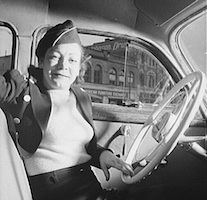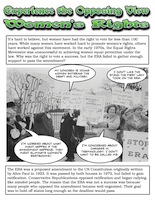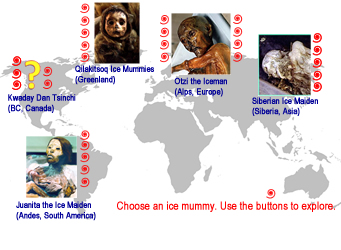 Primary Sources in Social Studies
Primary Sources in Social Studies
Primary source documents lay the foundation for historical inquiry. My GGGGGGrandfather William Kinnick was promoted quickly. Was it because he was a great soldier or because he was the only one left in his unit? Examining primary documents can provide insights.
My father has been posting diary entries from his mother's diary from 75 years ago in the Kinnick Project blog. When he first read the diaries, he was disappointed that they were mostly about everyday activities. It wasn't until he started making connections with other primary sources that the time period came alive.
Rather than using excerpts from primary documents like the article The Conscription a Great National Benefit from 1863, involve students in reading whole documents. Immerse them in history. Context is critical. Excerpts can easily be misunderstood when out of context.
Primary Sources & the Women's Movement
What do students need in terms of primary source materials in learning?
There are thousands of websites with many excerpts, but it's important to find the original source. For instance, many teachers provide students with the poem The New Paradise. However it's often given as text rather than within the larger book without the author, date, or other information to help establish the context. Instead, provide The New Womanhood by Winnifred Harper Cooley. The book provides the title, author, place, date, publisher, dedication, and context.
Try It!
If we just provide the poem, what information are students missing? Excerpts aren't enough. We need the context of primary sources. Are we providing students with the "whole picture"? Can you think of an example of a time when the digital reproduction is needed in additional to the transcription?
When studying the women's suffrage movement, students need the music, photos, maps, letters, diaries, and other original materials to get the whole picture of the time period or theme.
Students need to see the classic photos. Like First Vote in New York. However they also need to see the everyday person during the same time period. Examine the photograph below. What is she doing? Where is she from?
Consider the following questions:
- Where is she and what is she doing?
- What would it have been like to be a young woman with two small children living in rural Iowa in the 1910s?
- How would her life have been different than someone living somewhere else in the US or the world at the same time?
- How would her life be like and unlike a person today?
If you're interested, this is a photo of Annette Lamb's great grandmother Hazel Bolger taken in 1916.
Examine a woman working in a Salt Lake City law office or the group of high school teachers from Salt Lake City the 1910s.
Students then identify their own primary source and explore the perspective represented. Encourage them to select sources of personal interest. For example, the photo below left shows as woman in Salt Lake City in 1942 training to drive busses and taxicabs. The project on the right shows a student who selected a photo about the Women's Movement in the 1970s.
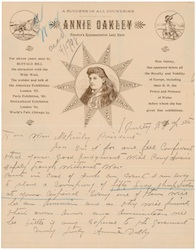 Try It!
Try It!
Read Annie Oakley's letter to President William McKinley from the National Archives.
NARA Description:
Letter to President William McKinley from Annie Oakley in which she offers the services of a company of fifty lady American sharpshooters who would provide their own arms and ammunition, to the government should war break out with Spain., 04/05/1898 - 04/05/1898
What other primary sources would help immerse students in history?
What other primary sources are related to this document and might be connected before or after this event?
How might this document fit into a larger, motivating theme?
Thematic Approaches to Teaching History
I teach two history courses: The History of Libraries and the Book: 1450+. The History of Libraries is taught chronologically and the Book: 1450+ is taught thematically with topics such as the book as an artifact, an author's work, intellectual property, a commodity, a cultural icon, a reader's perspective, etc. I've found that when teaching chronologically, students seem to get bogged down and often too focused on the names and dates. However the thematic approach becomes a story of the connection among people, places, and events. It makes the individual documents and pieces of information come together. I still use chronology, but it's within a context. I use chronology to help students see the patterns of change and flow of ideas over time.
Try It!
Is it "best" to teach history chronologically or thematically or both? Defend your position with examples.
In the mid 1990's the idea of teaching history thematic was very popular. However the standards movement of the 2000s stopped much of the progress.
Diana Laufenberg teaches American history thematically using the following a three step approach:
- Start by asking students to define the key concepts related to the theme through activities that explore their prior knowledge and analyze primary source documents. What is war? What is slavery? What is manifest destiny?
- Explore timelines, key events, and background information through small group activities that allow students to come together to share the central ideas. What are examples of war, slavery, and manifest destiny? How are these examples connected? What are the patterns?
- Involve students in developing arguments based on primary source evidence to address essential questions that ask how and why? Why do we have war?
Diana Laufenberg teaches American history thematically using the following topics:
- American identity
- Political participation
- War
- Business
- Balance of power
- American dream
- The environment
- Pivot points and what if
Mary Connor also uses a thematic approach using the following categories:
- American Character and Belief Systems
- The Immigrant Experience
- Struggles for Equality: Women, African-American, Native-Am, Asian-Am, Mexican-Am
- Boom and Bust: Economic Development and its Issues
- Leadership and the American Presidency
- American Cultural Traditions: Religion, Education, and the Arts
- War, Peace, and the Responsibilities of Global Leadership
Scott Small's approach focuses on eight themes:
- Introduction to US History
- Democracy and Republicanism
- Constitutionalism and Federalism
- Expansion and Industrialization
- Revolution, Reform, and Protest
- Immigration and Class
- Race and Racism
- War ad Peace
Other approaches include
- American's Ideals
- Prejudice and Discrimination
- Wealth and Poverty
- Social Justice
- Economic Opportunity and "Making a Living"
- War, Peace, and Conflict
- Social Organization
- Security and Freedom
- Belonging & Community
- Authority and Credit
- Individuals and the Collective Identity
- Social classes
- Democracy and Dictatorships
- Crime, Punishment and Deviance
- Religious and Philosophical World Views
- National Security
- Technology and Society
- The Nature of Democracy, Federalism and Government
- Property, Wealth, and Capital
- Rebels, Revolutionaries, and Reform
- Race & Racism
- Oppression and Rights
- Expansion and Industrialization
- Immigration and Class
Try It!
Discuss the strengths and weaknesses of the themes suggested. What's missing?
Select a theme that you'd like to develop for next year.
Talk about how librarians and teachers can work together.
Discuss the essential questions and key concepts.
Organizing Materials for Teaching and Learning
Think about how you'll organize primary source materials and other resources that will help guide your thematic story.
- Primary Sources. How will each primary source stand alone as well as add to the thematic story?
- Primary Source Sets. How might sets of materials be used for small groups or individual choice assignments?
- Nonfiction Books & Readings. How might primary and secondary readings be used in inquiry?
- Graphic Nonfiction History. How might graphic nonfiction be used in understanding the theme?
- Historical Fiction. How could historical fiction be used to help establish a context for the theme?
- Interactives. How can interactives be used to motivate and address individual differences?
- General Resources. How can other types of resources be incorporated with the theme?
- Teacher Resources. How can teacher resources save you planning time?
- Activities. How will you design scaffolds for learning and practice activities?
Resources for the Civil Rights Movement and Racism can be found with other themes on the Primary Resources: Themes page.
Think about how the 100 resources at Our Documents might be organized thematically.
Try It!
Think about the theme you discussed earlier.
Discuss what primary sources could serve as the core resources for one of these themes. How will primary sources help you tell the story?
What other resources are needed including background information, nonfiction readings, and historical fiction?
Discuss realistic ways these resources might be organized for students use.
Looking for ideas? Go to the
Primary Resources: Themes page.
Tips for Locating Primary Sources
- Search specifically for primary source documents such as muckrakers primary sources.
- When possible locate documents at Internet Archive without advertising. Look for the Project Gutenberg text version or a scanned document version. Also see if audio is available through LibriVox.
- Check out image sets from Flickr's Collections.
- Find interesting documents, then search for lessons. Use the title of the document, date, and the word lesson or activities such as Northwest Ordinance of 1787 lesson plans.
- Use Wikipedia to locate background information. Then, find the original source. For instance the Declaration of the Immediate Causes Which Induce and Justify the Secession Wikipedia article links to external locations for digital reproductions and transcriptions.
- Use Wikimedia Commons to locate quality documents. Then, link to the original source. This is particular helpful for world history because many countries are involved with Wikimedia Commons. You can find great images of Viking ships from Denmark.
- Use the Utah databases.
- Go to the new Digital Public Library of America (launching April 18, 2013)
Primary Source Activity Planning
Use in-class time to focus on primary source activities. Use out-of-class time to stress background information. Introduce documents as part of in-class activities to prevent students from Googling for interpretations. For instance, in-class have students compare The Promise of American Life by Herbert Croley with Wilson's New Freedom by Woodrow Wilson. Then, ask them to learn more "out of class".
- Identify the essential questions, key ideas, and standards being addressed such as "what can we learn about life in Roman times from the ruins of Pompeii?"
- Collect key documents related to the time period or theme. Go to Wikimedia Commons and Pompeiisites. Go to the Pompeii Interactive Dig for field notes, journals, and current information.
- Categorize documents in different ways (i.e., by type (i.e., diary, letter, treaty), by function (i.e., narrative/literary, diplomatic, social), by perspective (i.e., for, against, neutral), by author (i.e., general public, government, gender, social class)) and think about how they could be used as evidence in developing arguments or drawing conclusions.
- Identify key ideas. Consider how the documents can be used to understand the essential questions.
- Develop background information, opportunities for exploration, focused practice activities, and assessments. Adapt activity ideas from lessons you find to other time periods or sets of documents. Examples include Pompeii Interactive, Old Pompeii Lesson and Pompeii and the Roman Villa.
Try It!
Try the activity, Belief Systems of the Silk Road. Read your quote. Go to the category. Share and discuss. Adapt the activity with different content, sources, and categories. Download the Powerpoint and edit for your own categories.
Adaptations
Think about how you could adapt the idea of stations around the room:
- Stations
- Place artifacts in boxes or bags.
- Post photos around the room.
- Place computers around the room with audio excerpts. Listen to one fireside chat.
- Build maps, make timeline, create concept maps, and generate lists... transform information.
- Post computers around the room with video segments and activities.
- Put butcher block paper on the wall.
- Round 1: brainstorm key words; Round 2: define key words; Round 3: apply and connect
Try It!
What’s your favorite class activity?
What is it about this activity that engages students and increases retention?
A Couple Dozen Activity Ideas
- Abstract Concepts. Ask students to create a Wordle to go with a document that includes 5-10 key ideas that best reflect the core ideas of the document. Share the Wordles around the room. Ask students to use Post-it tags to identify three they think best represent the document. Use these three as the basis for a discussion or short writing assignment.
- Use War photos to discuss concepts related to war such as famous Vietnam era photos.
- Action Analysis. Create a set of cards (use PowerPoint to create cards) containing key document analysis questions. Each member of the small group takes a card. They analyze the document using their question. Next, go around and share their answers. Then, take a new set of cards and complete another round. The activity ends when they've worked their way through the cards.
- Use Library of Congress primary sets such as Assimilation through Education series.
- Artifacts in the Attic. Locate sets of historical artifacts at websites and online museums. Ask students to connect their artifact to some aspect of the class theme.
- The Object of History - learn to use historical objects in learning
- Wisconsin Historical Society: Quilts, Children's Clothing, Dolls, Ceramics, Moccasin, Samplers, Curator's Favorites
- Examples
- Comparison Capers. Comparisons are the easiest way to increase deep thinking.
- Compare the experiences of two presidents.
- 1963 - Kennedy at the Berlin Wall (photo)
- 1987 - Reagan at the Berlin Wall (1987)
- Compare two speeches. Don't give away the names or dates. Ask students to see if they can make an educated guess.
- 1976 - Democratic convention speech (speech) by Barbara Jordan
- 2004 - Democratic convention speech (speech) by Barack Obama
- Compare US Presidental Campaign Ads from 1952 to 2012.
- Compare satellite images using Income Inequity from Space. Can you find examples?
- Compare mistreatment of a people in two different documents.
- 1852 - Uncle Tom's Cabin by Harriet Beecher Stowe (fiction): slavery, Fugitive Slave Act of 1850 (also available in audio LibriVox) (also available as a scanned pages)
- 1881 - A Century of Dishonor by Helen Hunt Jackson (essay): mistreatment of the Indians, leads to Dawes Act of 1887
- Compare the experiences of two presidents.
- Connections Count! Provide students with four documents (i.e., Northwest Ordinance, the Homestead Act, the Pacific Railway Act, and the Morrill Act). Each student should get to know their document. As s small group, find connections among the documents and how they reflect a larger issue (i.e., explain the federal government's role in settling of the West).
- Try the activity with pairs. How are two documents connected? How could the pattern be extended? How are the Lee Resolution and Homestead Act related?
- Document Menu. Distribute a menu of three to five key documents. Write what you know about each document in the space provided. Each person is given one of the documents to analyze. They need to be ready to share the key features with others. During round one, students share their document with a classmate. They then switch documents. During round two, students need to share their new document. Hold as many rounds as you have documents. Ask students to revisit the document menu and see what areas they still need to learn more about. Discuss any confusion or misunderstandings in small groups or as a large group.
- An "Environment Lunch Menu" might include Yosemite Act (1864), Antiquities Act (1906), Wilderness Act (1964), Clean Air Act of 1970 (1970), and Archaeological Resources Protection Act (1979).
- Examples & Nonexamples. Use examples to show instances of the concept. Use nonexamples to distinguish things that are not instances of the concept. Provide three documents related to an event. Ask students to identify the document that... isn't a primary source, isn't an example of the concept (such as abolitionist perspective), isn't the same time period...
- Fence Sitting. Divide the class into three groups. Each group represents two sides and a neutral such as patriots, loyalists, and neutrals. The two sides will try to convince the neutrals to join their side. The two sides research their perspective and the neutrals write questions. One minute topics with 30 second rebuttals. Learn more at Fence Sitting Blog.
- Foundational Ideas. Analyze documents as a small group. Place key words around the room. Ask groups to place their documents in the area they best fit such as under a particular Amendment to the Constitution such as The Drunkards Progress with Amendment 18.
- Review: List the most important people, places, events, and ideas for the the time period
- What should everyone know about this people, place, event, idea, or artifact? Why?
- This person, place, event, idea, or artifact is like something I've studied before... how is it like BLANK?
- Games. Games involve goals, rules, feedback, and motivation. Any activity can be turned into a game with a few simple tweaks.
- Rather than working your way down a list of questions. Ask students to role the dice for the their question.
- Create a document analysis board game by placing questions on "spaces" where students stop after rolling a dice.
- Use cards from the Heritage Playing Card Company (i.e., Native Americans, UK topics) or any other set of images to get you started.
- The Iceberg. Draw an iceberg for an historical event. What's above the surface (i.e. people, places, events, ideas that are easy to recognize)? What's below the surface (i.e., the unseen tensions, stereotypes, frustrations, attitudes, causes, long term effects)? Demonstrate using the Native American Indian Schools as an example.
- Interactives Investigations. Students enjoy playing games and working their way through interactives. However they may not be missing key elements. Ask students evaluate the interactive, provide feedback, and build an extension such as additional primary sources. For instance, evaluate the Colonial Williamsburg Brickmaker interactive. Is it accurate? How do you know? Provide evidence to support your claims such as an artifact (i.e., brick mold).
- Historical Thinking Skills Interactives
- Social Studies Interactives
- General: PBS LearningMedia, Conflict Map Game, Nuclear Weapons Game, Red Cross Game
- Civics and Government: PBS Interactives, Democracies in the World, Architect's Virtual Capitol, Top Secret America, To Lie or Not Lie
- Culture, Sociology & Psychology: PBS Interactives, Autism Quiz, Mind Lab, This Emotional Life, The Responsibility Project, Brainstretcher, Photofit Me, Photographic Memory Test,
- Economics: PBS Interactives, Trade Theory Game, Economics
- Geography: PBS Interactives, National Geographic, BBC: Dimensions
- U.S. History: PBS Interactives (check topics for more), John Smith Historical Map Interactive, Freedom Riders, History Games, Historical and Cultural Contexts, Do History, Explorations, Mission US: Flight to Freedom, Mission US: For Crown or Colony?
- World History: PBS Nova, PBS Interactives (check topics for more), 19th Century France, Out My Window, Tiziano Project, Collapse, Great Thinkers, Industrial Revolution in Britain, Middle Ages, Renaissance, National Archives (UK)
- Government, Civics, and Economics: Bank it or Bust, It Costs What?, Rags to Riches
- Interactive Slide Show: Julian the Trailblazer
- Jigsaw. Developed by Elliot Arnson, this approach involves learners becoming experts in a document and sharing their expertise with others. Groups are formed to analyze documents related to a theme. Each group member is charged with becoming an expert in one document. Expert groups meet to analyze their document. Students return to their original group to share what they're learned about their document. The group discusses how each document contributes that a whole understanding of the person, place, event, or idea. Use document sets like Bison Skull Pile.
- Matching Mania. Read primary source documents. Provide an image and short biography on three people. Connect the people with their documents. Provide reasons. For instance, explore the documents created individually and collaboratively by John Adams, Benjamin Franklin, Alexander Hamilton, John Jay, Thomas Jefferson, James Madison, and George Washington. Use a variety of documents such as the Jay Treaty.
- Perspectives
- Examine two documents containing different perspectives. Create a concept map with the key ideas down the middle and the points of view on each side.
- Look for different perspectives in various newspaper articles on the topic of the Emancipation Proclamation. Does the location of the paper impact the perspective? Is this bias?
- Look for different perspectives on Prohibition (newspaper articles from 1919).
- Start with reading the Keating-Owen Child Labor Acts of 1916 (act). Break into small groups of four. Each student takes a different letter to analyze. They then come together and compare the perspectives of the letter's author.
- 1916 - Letter from Suzanne Heber Supporting Keating-Owen Child Labor Bill (letter)
- 1916 - Letter from Lyons Township High School Students supporting Keating-Owen Child Labor Bill (letter)
- 1916 - Letter from Marshall Dilling Opposing Keating-Own Child Labor Bill (letter)
- 1916 - Letter from Operatives of Cherokee Falls Manufacturing Company Cotton Mill in Opposition to Keating-Owen Child Labor Bill (letter)
- Create two columns for two points of view or create a Venn Diagram
- The Right Foot. It's essential that the first experience a student has with a topic be accurate. Students are most likely to remember their first encounter more than subsequent experiences, so be sure to provide a concise, correct demonstration or explanation before looking at common errors or problems. Conduct a short demonstration or overview of the topic and do a quick check of understanding.
- Scrapbooking. Each group gets a set of documents. Around the room are characters with specific interests. The group must decide which scrapbook would contain their documents.
- Sequence Content. Without knowledge of the dates of the documents, ask students to sequence the documents. How did public opinion on an issue change over time? How did marketing strategies evolve. Use Google Patents for ideas.
- Then and Now. Working in small groups, students select a topic related to the class theme. Individually they select two documents, one representing "then" and one representing "now". Analyze and compare the documents. Put together a group newsletter. Use the Our Community: Then & Now example for ideas.
- Think. Pair, Share. Individuals analyze a document. Two people share their thoughts and exchange ideas. The pairs share their ideas with a small group.
- 1919 - Let Your Fruit Trees Save Sugar (cartoon)
- 1925 - Enforcement of Food Law (letter) from Harvey Wiley to President Coolidge
- 1941 - Save Every Drop of Oil or Fat (poster)
- 1941 - Sugar-Flour-Cereal-Space Canned Food (poster)
- 1942 - Victory Garden Plots (poster)
- 1943 - Frequent Watering of the Victory Garden (photo)
- 1941-1945 - Your Victory Garden (poster)
- 1946 - Mrs. Fidel Romero Proudly Exhibits her Canned Food (photo)
- 1974 - Maple Syrup (photo)
- Thumbs Up or Thumbs Down. Distribute editorial documents and character cards (i.e., southern sympathizer, abolitionist, plantation slave owner). Ask students to share their document with a peer and talk about whether they think it's an effective argument and whether their character would agree or disagree with the position represented. Debrief with a review chart showing best choices.
- Triangulation. Look at multiple documents regarding a single event. What really happened? As a small group, on poster paper create a map and timeline showing what may have happened based on information from witness accounts.
- Who Fired the Shot Heard 'Round the World? Start with the Disposition of Captain John Parker (page 1, page 2, transcription). Analyze the Dispositions. Lesson Idea.
- Website Focus. Identify a website that contains both good primary sources as well as background information. Use this site to introduce and model specific primary source skills.
- Whole Group Analysis. Provide students with background information. Present a primary source document. Ask guiding questions. Use a DBQ approach.
Adapt: Use your own documents. You can build your own in a word processor and have them ready to use.
Lesson Ideas:- Go to the National Archives (UK). Explore a few lessons.
- 1233 - A Medieval Mystery
- 1086 - Doomesday Book
- 1400s - Chertsey
- 1536 - Henry VIII Court Rules
- 1567 - Kirk o' Field
- 1581 - The Royal Seal
- 1588 - God Blew and They Were Scattered
- 1588 - Elizabethan Propaganda
- 1605 - Gunpowder Plot
- 1607 - Native Americans
- 1649 - The King, the Crown and the Colonel
- 1623 - William Shakespeare
- 1665 - Great Plague of 1665-6
- 1666 - Fire of London
- Go to Exploring US History. Explore a few lessons.
- 1600s - Indentured Servitude
- 1774 - Society of Patriotic Women
- 1850s - Alien Menace
- 1919 - Gangsters
- Go to the National Archives (UK). Explore a few lessons.
Teacher Resource Materials
Explore other activity ideas at TeachingHistory.
The America's History in the Making from Annenberg Learner provides lots of professional development materials for history teachers.
America's History in the Making: Resource Archive from Annenberg Learner contains resources for each time period with explanations. These would serve as good models to get started.
Use Edsitement, PBS Learning Media and Teacher's Domain for photo sets and activities. Search for "primary sources".
Classroom Management
The key to fluid environments is connecting students to resources as well as tools for building social and collaborative connections. Create learning experiences that build concepts and skills through whole group, collaborative team, individual work, and global experience.
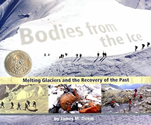 Whole Group. Watch NOVA Ice Mummies program on DVD and explore the NOVA Ice Mummies website. Watch The Ice Mummy from Discovery channel. Explore general ice mummie resources:
Whole Group. Watch NOVA Ice Mummies program on DVD and explore the NOVA Ice Mummies website. Watch The Ice Mummy from Discovery channel. Explore general ice mummie resources:
- Student Website: Ice Mummies
- Paper Book: Bodies from the Ice: Melting Glaciers and the Recovery of the Past by James M. Deem
- eBook: Ice Mummies by Eric Kudalis
- Video: How do ice mummies form?
Collaborative Team. Explore ice mummies from around the world. Then share the similarities and differences.
Click the image below to see the image map web page with links to information about each ice mummy.
Individual Work. Explore an area of interest and report back to the group.
- What did these people really look like? Watch the Juanita Ampato Ice Maiden Photoshop Reconstruction.
- How did these people die? Explore the lesson Who Killed the Iceman?
- Why are they finding so many dead mountain climber bodies?
Global Connection. Encourage students to explore their own questions and interests.
- How do ice mummies related to other types of mummies? How are they alike and different?
- How are real mummies different than those found in the movies?
- How are mummies preserved in museums?
Resources
Wineburg, Samuel S. (1991). Historical problem solving. Journal of Educational Psychology, 83(1), 73-87.
Wineburg, Samuel S., Martin, Daisy, Monte-Sano, Chauncey (2012). Reading Like a Historian: Teaching Literacy in Middle and High School History Classes. Teachers College Press.



